I hope everyone has been enjoying Science Week so far. Here in Galway we have the wonderful Science and Technology Festival that runs for two full weeks with lots of activities around the city and county. Read more
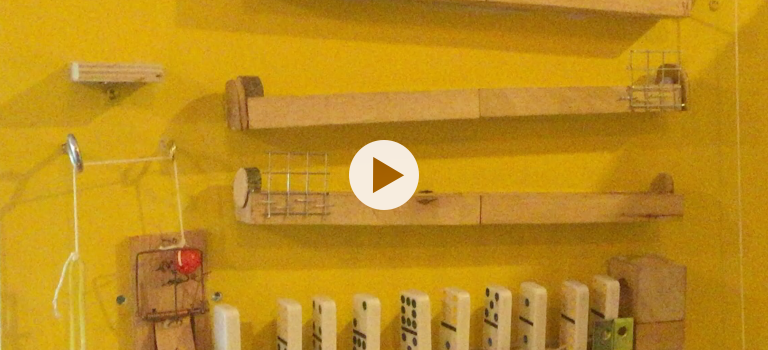
Science, Curiosity and Life

I hope everyone has been enjoying Science Week so far. Here in Galway we have the wonderful Science and Technology Festival that runs for two full weeks with lots of activities around the city and county. Read more
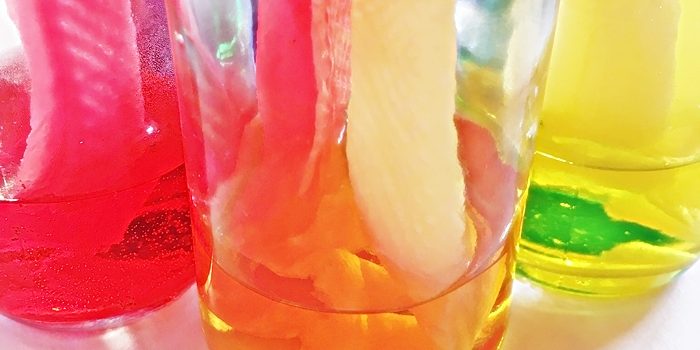
Can water go uphill? The answer is… yes it can! In some ways anyway; water can travel upwards by a process called capillary action.
Capillary action can be described as water climbing upwards due to weak forces created between the water molecules and the material the water moves up along, or through. In the experiment below the water travels up the paper towel, forming these forces with the paper towel as it creeps upwards.
We arranged our six bottles in a circle (but you could do this in a straight line too, if you want to create the same colours as us, you will need seven bottles in a straight line, with one colour repeated… think about it 😉 )
Half fill every second bottle with water, leave the other bottles in between empty.
Add a few drops of food colouring to each bottle containing water, red in one, yellow in the next and blue in the next.
Now take a piece of the folded paper towel and place one end into the bottle containing red-coloured water, and the other end into the empty bottle beside it; make sure the paper towel sits into the coloured water.
Take another paper towel and place one end in the empty bottle (that is now connected to the red-coloured water bottle) and the other end into the bottle containing yellow-coloured water.
Repeat this all around the circle so that the paper towel ‘wick’ goes from the yellow-coloured water bottle to an empty bottle and another from that empty bottle to the blue-coloured water bottle; finally place a paper towel ‘wick’ from the blue-coloured water bottle to an empty bottle and another from that empty bottle to the red-coloured water bottle.
When all set up it will look like this…
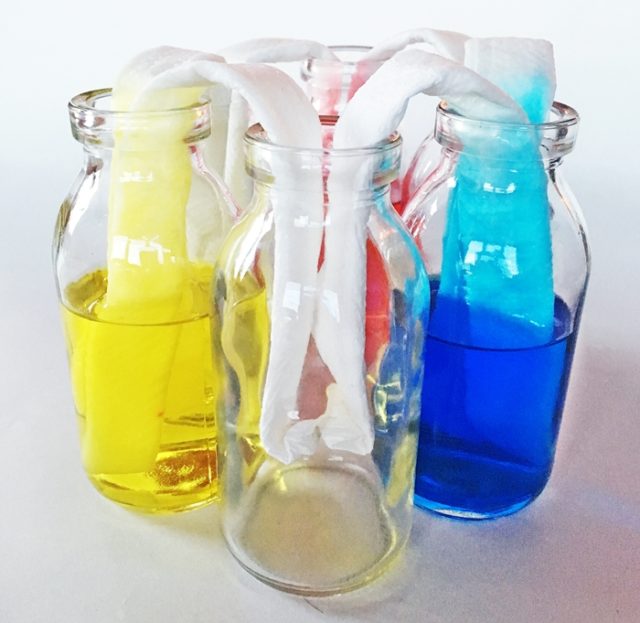
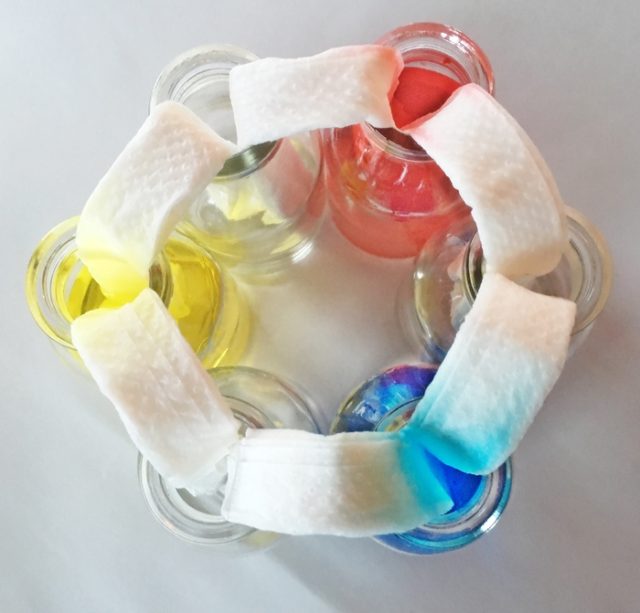
Then all you have to do is wait! You should see the water starting to climb up the paper towel ‘wicks’ within a few minutes. Leave the experiment for a few hours or overnight to get the final result.
Eventually the water will travel up one side of the paper towel and down the other side, starting to fill the empty bottle. As water comes into the empty bottle from each side, the two colours of water will mix.
The red and yellow-coloured waters will mix in the bottle between them, creating orange-coloured water.
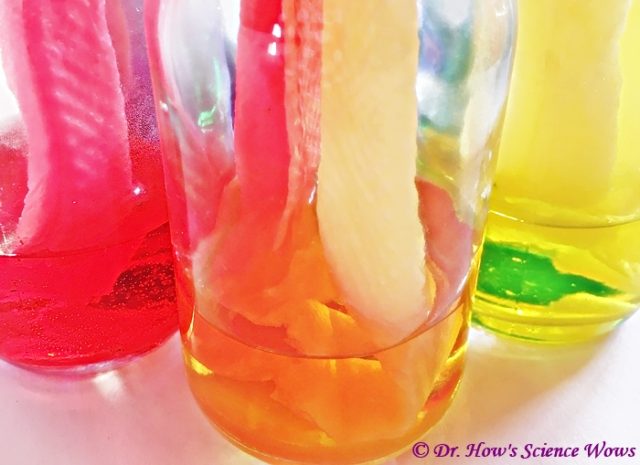
The yellow and blue-coloured waters will mix in the bottle between them, creating green-coloured water.
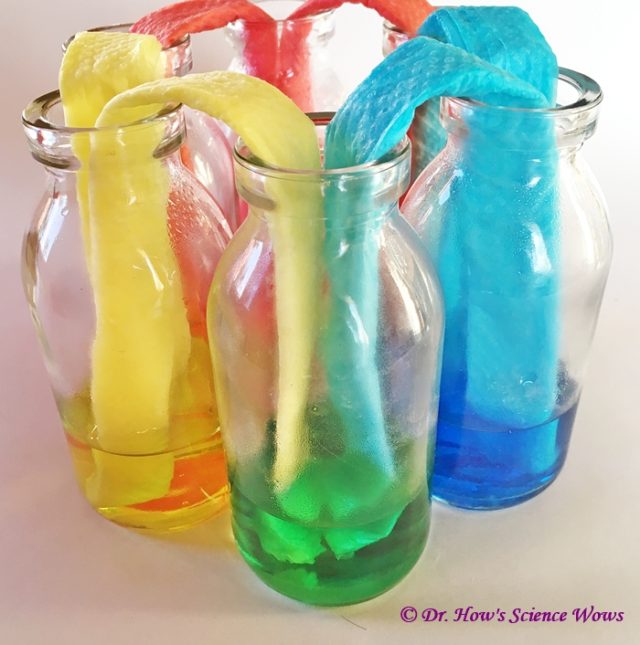
The blue and red-coloured waters will mix in the bottle between them, creating indigo-coloured water.
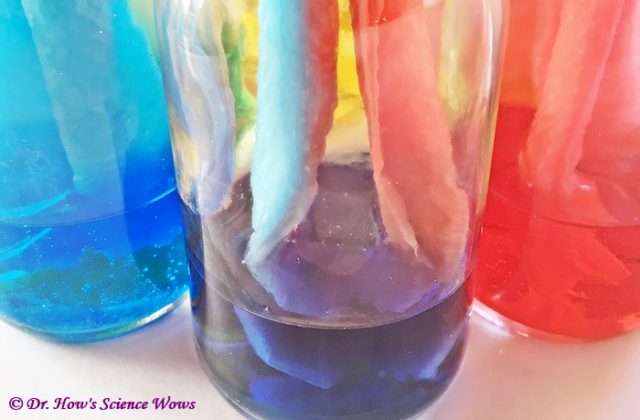
You will notice that all the bottles have now got about the same amount of water in them. Once this happens no more water will transfer between bottles.
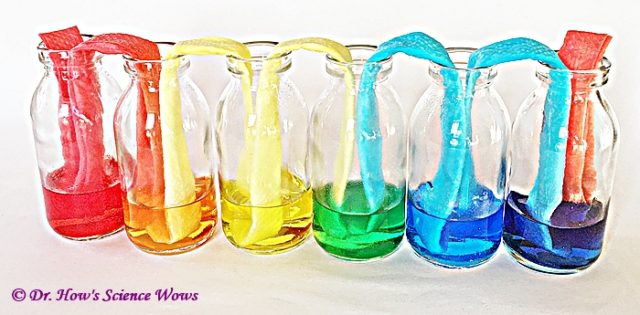
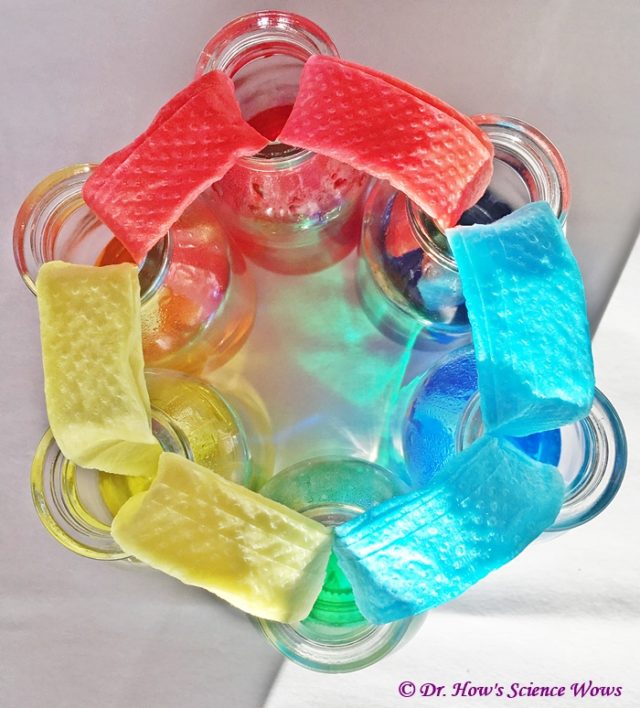
As mentioned above, the water is able to climb up the paper towel due to these forces, called adhesive forces, that form between the water molecules and the paper towel. This process is called capillary action.
********
On the subject of water, if you ever wondered why our fingers wrinkle in the bath check out my recent Appliance of Science column in the Irish Examiner.
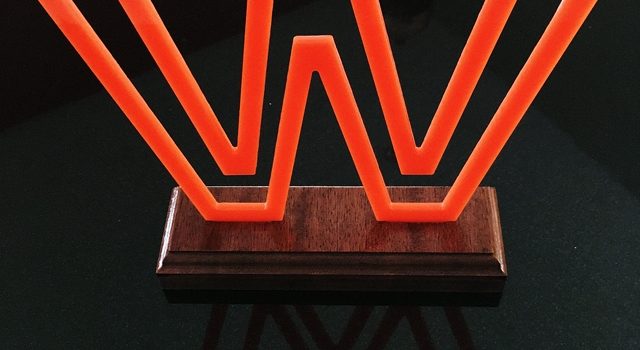
Last week had some really big dates in my diary. On 28th September my youngest child turned seven…. and the Realex Web Awards were on in Liberty Hall Theatre in Dublin. It was a case of nothing on for weeks and then everything falling on the one day. I was looking forward to starting the day with the excitement of opening presents with a brand new seven year old and finishing the day with the excitement of the awards. Things don’t always go to plan though and when a sick child was thrown into the works it was time to settle for a virtual awards ceremony via twitter and the trending #RealexWebs16 hashtag.
So I made the school lunches with phone in hand, while following along with the announcement of each winner. I reluctantly put the phone away while I helped put the kids to bed, having extra cuddles and chats with the seven year old after his very exciting day. When all were tucked up in bed I took my phone up again. It was with great shock that I noticed Science Wows mentioned, as I scrolled through the tweets.
I had just won BEST EDUCATION/THIRD LEVEL WEBSITE!
It took a moment to sink it and I was probably the only pyjama clad winner on the night, but it didn’t stop me celebrating! Everyone was back out of bed with all my excited shouting and there was lots of hugging and jumping about (that may have been me more than the children, but let’s include everyone in the activity for the sake of the memory!). Needless to say I was very shocked and very, very, pleased!
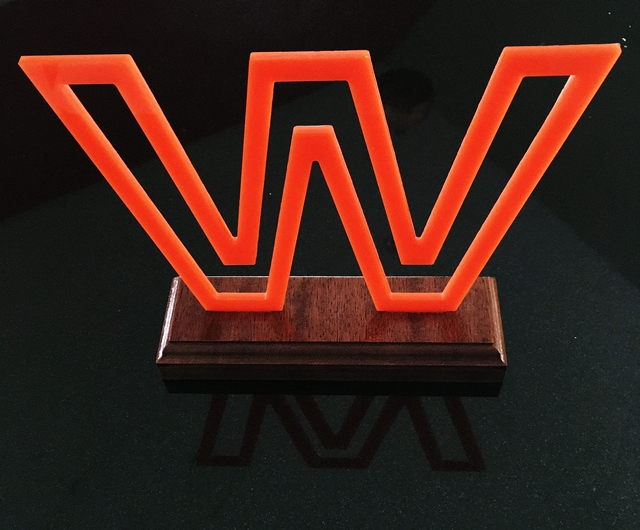
I set up Science Wows five years ago, and it has been a wonderful learning curve and a true labour of love. This website and blog have become a passion. I love that they provide a medium to share everything I want to share. A tool to talk, to design, to challenge, to experiment and to learn; and it is a two way communication. Sometimes it has been a lonely road but the highs have been great. For all the hours spent writing, or researching or testing are always balanced by the comments and the interaction and the feedback. And for this I am truly grateful. The feedback on the night of September 28th is more than I ever imagined.
Thank you all for the journey so far; for reading and interacting, for sending in your questions and ideas. For the support and encouragement and tips and advice. I didn’t make it onto the stage to thank you all on the night but I’d like to say it now!
******
I’d also like to say a very big thank you to David from A Tribal Vision for stepping in and accepting the award for me. The website shares a beautiful project, a series of interview conducted with some of Galway’s most creative and innovative individuals. Make sure to take a look.
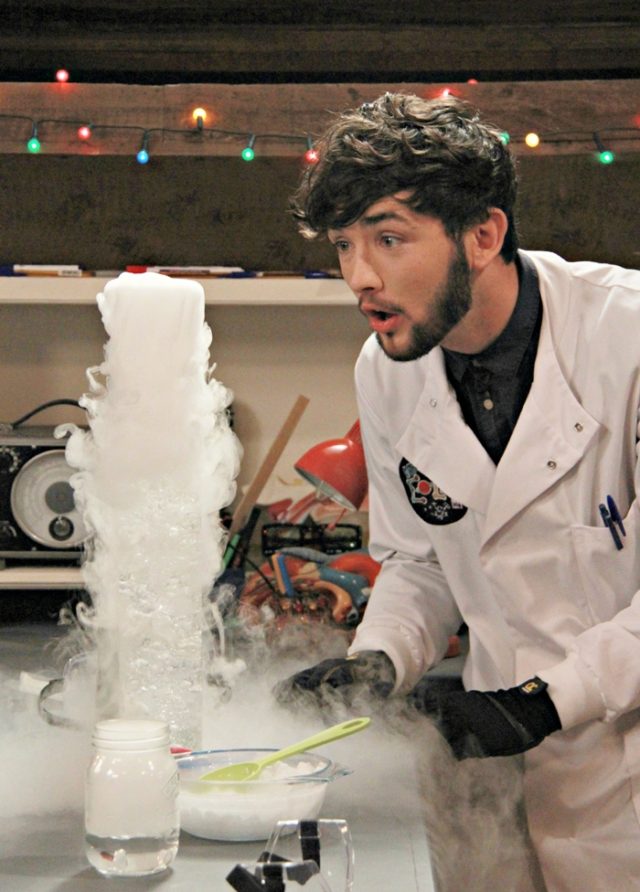
I am delighted to tell you that Is Eolaí Mé is starting next Tuesday 20th September, on Cúla 4, TG4, at 17.25pm. It has been almost a year since filming of the show wrapped, you can take a look at my behind the scenes account here. As consultant and script writer on the show, I am extremely excited to be able to finally watch it on TV.
Here is a little preview…
Each show will be jam packed with lots of amazing Science. The presenters, Una and Peadar will explore a different theme each week… and explore is definitely the right word to use; they will be out and about finding fun ways that science is used in real life. From rocket launching to surviving an indoor storm and so much more in between. I
Is Eolaí Mé is presented by Peadar Ó Goill & Úna Ní Fhlatharta and produced by Fíbín.
Each week Una will be joined by a group of children, keen to help her roaming reporting on the science topic of the day.
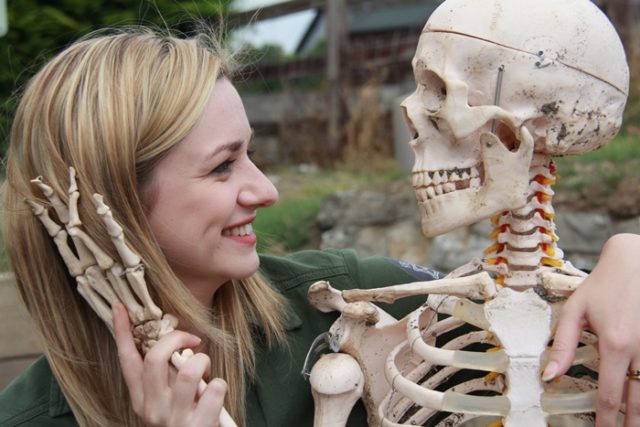
When Peadar is not out testing his endurance skills in the name of science, he will be in his amazing loft lab, testing theories, trying out the latest experiments and even sharing ones to do at home.

Peadar will be joined in his loft by some amazing young scientists who are always up for the adrenaline-pumped science challenge of the day.
Then there are the antics of An t-Ollamh Ullamh and his reluctant side-kick, Aodh, that will definitely add an hilarious comic angle to each programme.
And all that is only the tip of the iceburg, you will be amazed at just how much science is packed into the half-hour programme. So set your alarm clocks, tell your parents and teachers and get ready for kick off next Tuesday! The show will air twice a week, for double the fun; Tuesdays and Thursday at 17.25, and, of course, also available on TG4/Cúla 4 player.
I’ll leave you with this little video… showing Peadar running across a bath of white liquid! How does he do it? You’ll have to tune in to find out!
Check it out… Is Eolaí Mé, every Tuesday and Thursday, 17.25 on Culá 4, TG4. Starting 20th September, 2016.
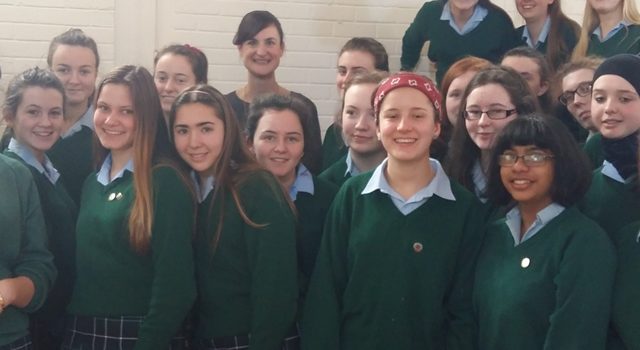
Positive role models are always a great way to inspire the next generation. Ada Lovelace, the amazing programmer and mathematician is one such role model. The Ada Lovelace Initiative (A.L.I), named in her honor, is a community initiative set up to provide such positive role models, to highlight just how important, and able, women are in Tech and STEM.
Ada Lovelace – the original inspiration
Ada was born Augusta Ada Byron in 1815. Her father was the famous poet, Lord Byron and her mother was Lady Anne Isabella Milbanke Byron. It was her mother that would ultimately influence Ada’s academic advancement. After separating from Lord Byron she felt that an education was important for her daughter, to keep her mind engage and free from the mood swings she experienced in her estranged husband. Lady Anne arranged a series of tutors to teach her young daughter in the areas of language, mathematics and science.
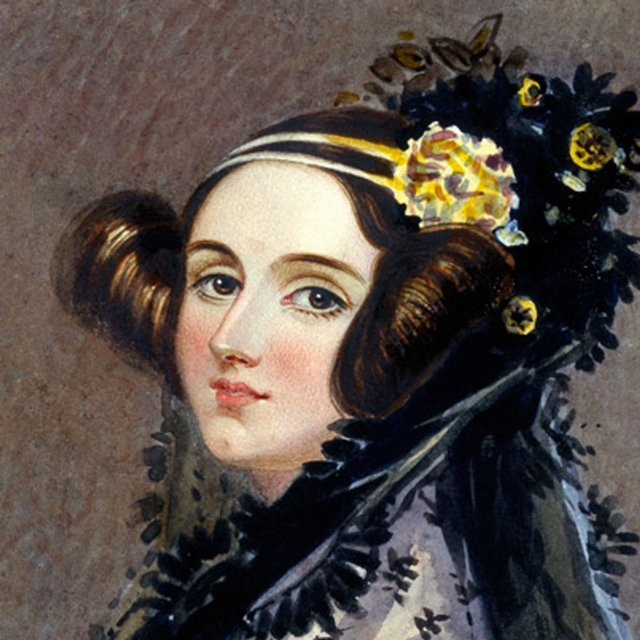
From an early age Ada showed a flair for mathematics and languages. A meeting with the inventor Charles Babbage lead to a lifelong friendship and further access to academic teachings and theories and the time. It was while Ada was commissioned to translate an article on Babbages’ analytical engines that she added her own notes and theories and expanded the application of the machine into the realm of a real computer. Her works were published at the time but it was not until more than 100 years later that they were republished at the dawning of the modern computer. That is certainly a woman ahead of her time.
Ada is considered by many to have been the first computer programmers and a brilliant mathematician. She referred to herself as an analyst and metaphysician. Whatever title she held it cannot be denied that she is a wonderful role model in any era.
The Ada Lovelace Initiative – the modern day inspiration
The Ada Lovelace Initiative (A.L.I.) was set up in 2015 by Verify Recruitment. They responded to the startlingly low representation of women in the tech sector (only 25% of the STEM workforce is comprised of female professionals) in an inspiring way. They saw the strong and significant contribution made by the small number of women that do work in technology and realised what a valuable link they can be to the next generation. They set up A.L.I. in 2015 to bring these female role models right to the girls that need to hear their story.
A.L.I. connects female professionals working in technology with Transition Year secondary school students to present to students an insight into working in technology by telling their story. Women from the technology sector tell students about their educational background, their role type how they chose their career path.
In less than a year A.L.I. has reached approximately 3000 students in 14 counties in Ireland. The goal for 2016/2017 is to reach at least 5000 students in schools across the country.
By improving the information channels available to directly inspire girls to consider careers in this field, we believe that the role models can deliver invaluable advice and give the students a taste of the real-world of technology. Cathal Grogan, Director of Verify Recruitment.
There are already over 100 role models from 75 technology companies in Ireland registered as volunteers for The Ada Lovelace Initiative. Volunteers have registered from companies such as TripAdvisor, Udemy, Citi and Concern Worldwide to encourage young women to choose a career in technology.
One such mentor, Louise Bernstein, Senior Product Manager at ALTIFY had this to say:
“Today, no matter the career path girls choose – from chemical engineering to organising music festivals – tech will be in the background automating, speeding up, integrating, and uncovering new ways to achieve goals. Yet, less than 30% of women are involved in how that technology shapes their lives. I want to encourage more women to sit at the tech table, and be part of that future. By improving the information channels available to directly inspire girls to consider careers in this field, the voluntary role models of The Ada Lovelace Initiative deliver authentic career advice and give the students an insight into the real-world of working in technology.”
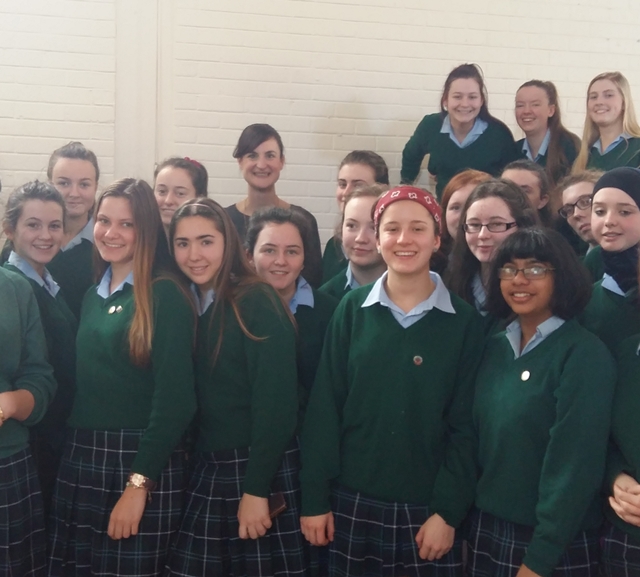
Photo: Louise Bernstein, A.L.I. Role Model with the 2016 Transition Year pupils of Rathdown School, Glenageary, County Dublin
For more information about the Ada Lovelace Initiative, to register your interest as a technology role model here or to register your school – please visit www.verifyrecruitment.com/ali
#AliMyStory is a voluntary initiative and the visits are provided free of charge to schools who would like to introduce a role model to their students.
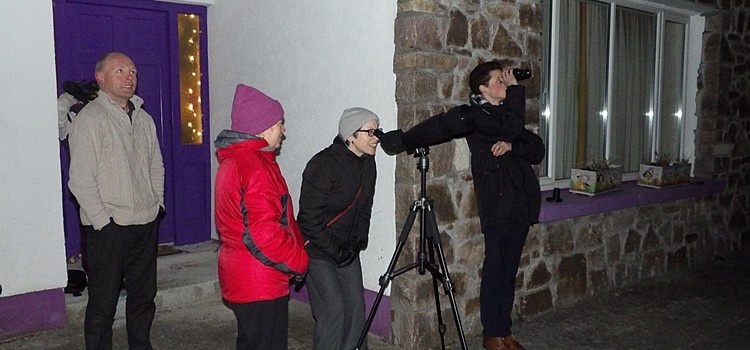
Have you spotted Jupiter in our lovely clear skies this week? It is very bright and visible to the naked eye. We got the kids out of bed at nine O’ clock last night just to have a look (they may have been more interested in running around in the dark than in actually looking up at the sky!).
This was our view from our front door, a lovely full moon and Jupiter up above it (I obviously don’t have the steadiest hand as Jupiter looks more like a squiggle line than a round object, but you get the idea)…

Jupiter is one of the brightest objects in our night skies (after the Moon and Venus), and is particularly bright at the moment as the (almost full) moon swings near it.
Easy to see with the naked eye, some of its moons are also visible when viewed through a binoculars. We couldn’t view them this way (more shaky hands) but, luckily Mr. Science Wows had the telescope all set up and ready and then we got a real treat.

We were able to see three of Jupiter’s moons, as well as the striped appearance of this giant planet. Quite a spectacle.

Here are some more facts about this amazing planet…
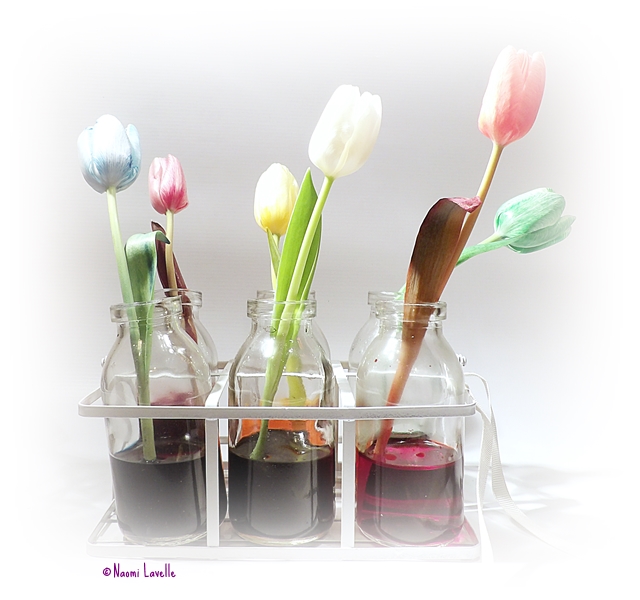
I know I haven’t been blogging much lately, I am trying to work on a little something else that I have wanted to do for a very long time. If I ever get the other project finished I’ll be sharing it right here so watch this space (not literally, it’s taking me a LONG time!).
There is still plenty of science going on in the background though, as is common enough around here. This week we repeated an old favourite, an experiment demonstrating water flow and transpiration in plants… our coloured flower science experiment. I spotted a bunch of pretty white tulips in my local super market and that was all the reason I needed. I had also spotted a set of little bottles while away in Westport last weekend and had to buy them for this experiment, which, I think, elevates my geek status to a whole new level.
I have blogged about this topic before, so if you want more information you can check out this post.
YOU WILL NEED:
*This will work with all (or almost all) white flowers but it works better with some than others. You can of course use other coloured flowers, daffodils are a popular choice. I have achieved good results with roses, carnations, oxeye daisies and some Chrysanthemums. You can choose the flowers based on what you want to achieve but if working with children (particularly young children) or doing this as a classroom project them I would definitely recommend the tulips. The results are rapid so children will be able to see the colour arriving into the flowers within a fairly short time frame.
WHAT TO DO:
Choose how many different colours you want to use. Place one colour into each glass and add water. I usually use at least 10 mls of food colouring to 20 mls of water (if unsure use a 50:50 ration of food colouring to water).
Choose your flowers, one for each glass, and trim them to the desired length. You will get a more rapid result with a shorter stem.
Then simple place a flower in each glass and wait! With these tulips I began to see a result within less than an hour. I set this experiment up overnight and went from this…
… to this…
WHAT IS HAPPENING:
Water is transported up the stem of the flower through little tubes called xylem. The coloured water will travel through the xylem all the way up the stem to various parts of the plant and right up to the flower. The coloured water stains the plant as it moves through it and this is most apparent when the white flowers change colour. The water ultimately evaporates out of the plant through little pores called stromata. This process is called transpiration and is much like perspiration in humans.
OTHER SUGGESTIONS:
If you want to take this one step further you can try to make a multicoloured flower, like I did with this rose last year. Just click on the image to go to the post with full instructions.
If you try this experiment, or a version of it, I would love to hear how it you get on!
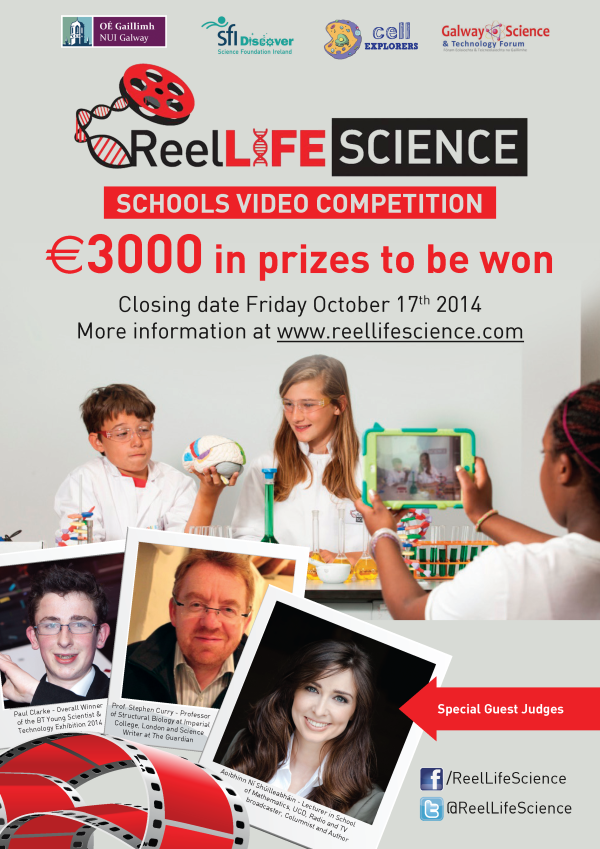
Schools, children, parents, teachers… listen up! There is a great competition (by Reel Life Science) running at the moment where pupils from both primary and secondary schools are invited to make a three minute science video with a chance to win €1000 for their school.
The competition is a wonderful way to get pupils, their schools, and families interested in Science from a new perspective… from behind the video lens. Launched last year in Galway the competition was so successful it has now gone nationwide!
The competition is broken down into a number of different categories so there is a lot of scope to develop and document your own favourite scientific topic.
PRIMARY SCHOOL TOPICS
SECONDARY SCHOOL TOPICS
If you need some inspiration there have been a number of guest posts from professionals in each area sharing some of their research or opinions on each topic. You can check them out here.
There is even a post from Dr. How’s Science Wows to help inspire you on the topic of Science in the Garden. However, I enlisted the help of some resident “experts” so you may find it more humorous than inspiring. Check it out here if you want to see what happens when you combine “mischief” and science!
This is a fantastic opportunity and is a very unique competition in Ireland, so please spread the word and get your school or classroom involved.
CLOSING DATE FOR VIDEO SUBMISSION IS FRIDAY OCTOBER 17th SO DUST OF YOUR LENS AND PUT YOUR THINKING CAPS ON AS IT IS TIME TO LET THE CAMERAS ROLL.
You can check out the Reel Life Science website for tips, advice and guidelines or follow them on twitter and facebook to keep up to date!

This week’s Fun Friday post is a round up of all our favourite sound experiments and facts. Hear it, make it, feel it and even see it… guaranteed for a weekend full of fun!

We love this simple experiment to make a spooky sound cup… see what kind of sounds you can make with it.
Just click on this link to find out what to do…

All you need for this one is a balloon and a radio or other music player.
Blow up a balloon and tie it. Turn on the radio to a song with low base music. Hold the balloon between your two hands and hold it very
near the speaker of the radio.
What can you feel?
Change to a different radio station and see if the vibrations change.

This one never ceases to get a WOW from everyone, and for a change Dr. How is on the other side of the camera to show how it works … click on this link to check it out.
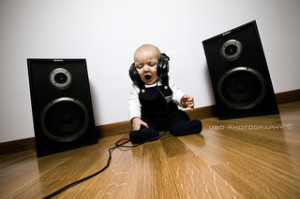
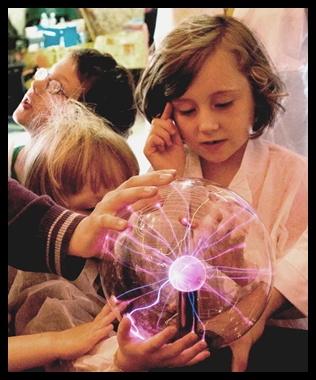
As a mother I have watched with fascination at how my children grow and learn, constantly testing, evaluating and questioning life around them. For Newton (at the age of 23) it was apparently an apple from a tree that led to his evaluation of gravity but have you ever observed a toddler in a high chair dropping their spoon? Every parent I know has gone through this phase with eventual exasperation, but look at it through the child’s eyes…. why does it always fall down? Why does it not fall upwards and stick to the ceiling? Over and over again they test their results, natural scientists!
It has become an interest of mine to observe how our environment, lifestyles and educational facilities feed this wealth of natural scientific curiosity. As my children passed through playschool and Montessori I observed the wonderful manner of learning and development through play and interaction that is encouraged through the guidelines of Aistear (the Early Childhood Curriculum Framework).
“Tell me and I forget; show me and I may remember; involve me and I learn.” Benjamin Franklin
Now that my older children have moved into primary school I notice things are very different from my day. Technology has made it to the classroom! Chalk and blackboard have largely been replaced with interactive white boards and computers.
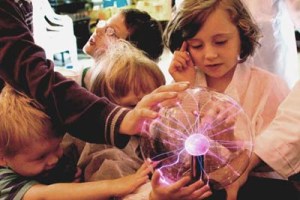 The internet has opened up a wealth of learning for our children where they can link to others on an international level to promote their learning in STEM (Science, Technology, Engineering and Maths) subjects. Our local school uses Manga High for interactive maths games, quizzes and learning. Children are being educated in computers and programming technology through the global collaboration that is CoderDojo!
The internet has opened up a wealth of learning for our children where they can link to others on an international level to promote their learning in STEM (Science, Technology, Engineering and Maths) subjects. Our local school uses Manga High for interactive maths games, quizzes and learning. Children are being educated in computers and programming technology through the global collaboration that is CoderDojo!
What about how science is taught in our primary schools? The curriculum encourages children to learn through investigation and exploration of their physical and natural surroundings. Teachers are encouraged to promote hands-on learning and it is certainly a requirement in the training of new teaching staff. Online resources are available to encourage and assist in the teaching of science in the classroom. The reality depends on how comfortable the teacher feels with the subject, the class sizes and time! In my experience of bringing interactive science to the classroom, I have found the two types of teachers that show the most enthusiasm for what I do are those that are madly into science themselves and those that are totally intimidated by it!
Outside of the school environment there is more to stimulate the young scientist than ever before. The Aquarium is a favourite in our family, as is the Zoology department at our local University. We took in an interactive display on oscillation at the Science Gallery, on our last trip to Dublin. The National History Museum is next on our list along with a science walking tour. School holidays can now be filled with science camps, construction camps and outdoor nature workshops, to name but a few.
My observations have shown me how much has changed since my school days. I learnt science from a book with little emphasis on questioning. I am pleased to see that my children learn in an environment that encourages questioning and active exploration. Just as they began their scientific enquiry with the early dropping of the spoon, they are moving through a life that is rich in scientific options, wonder and promotion. It is even written into their school curriculum! I have also learnt through my children, I am learning now more than ever, by simply….. looking at life through the eyes of a child!
This article originally appeared as a “guest post” on sciencecalling.com